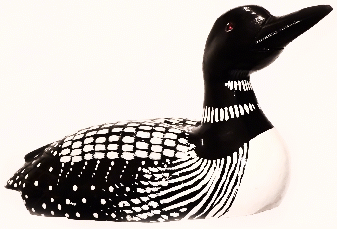
Picture of a Common Loon or Great Northern Diver carved from wood.
|
The Red Throated Loon or Red Throated
Diver (Gavia stellata) is the species with the widest distribution.
This bird has a dark bay colouration on the throat of the adult during
Summer. Despite this ornament, it is the least conspicuous, as it
is also the smallest, species of the genus, the back and upper plumage
being of a blackish-brown with, a, few insignificant white spots, while
the head and sides of the neck are ash-coloured, bounded by a long nuchal
band, which lower down advances towards, the breast, of feathers marked
with black, grey, and white, to form regular stripes.
The next bird up in the order of size is the Arctic
Loon or Black-throated Diver (Gavia arctica), which has a head
of light gray colour, and a purple-black gular pouch. Above this
pouch the Arctic Loon has a white half-collar which has vertical black
stripes, while two patches on the black back, between the shoulders,
as well as the scapulars, are conspicuously marked with large sub-quadrangular
white spots.
The Pacific Loon or Pacific Diver
(Gavia pacifica) is very similar in appearance with the Arctic Loon or
Black-throated Diver (Gavia arctica), and it it thought by some ornitholgists
to be the same species. The distinguishing difference is that the
Pacific Loon lacks the white flank patch which is present in the Arctic
Loon.
Larger still is the Common Loon or Great
Northern Diver (Gavia immer) which has a black glossy neck and head,
2 half-collars of white with black vertical stripes, and almost the entire
black back and upper wing surface elegantly marked with white spots which
vary in size and are arranged in belts.
|





